Lyons W.C. (ed.). Standard handbook of petroleum and natural gas engineering.2001- Volume 1
Подождите немного. Документ загружается.

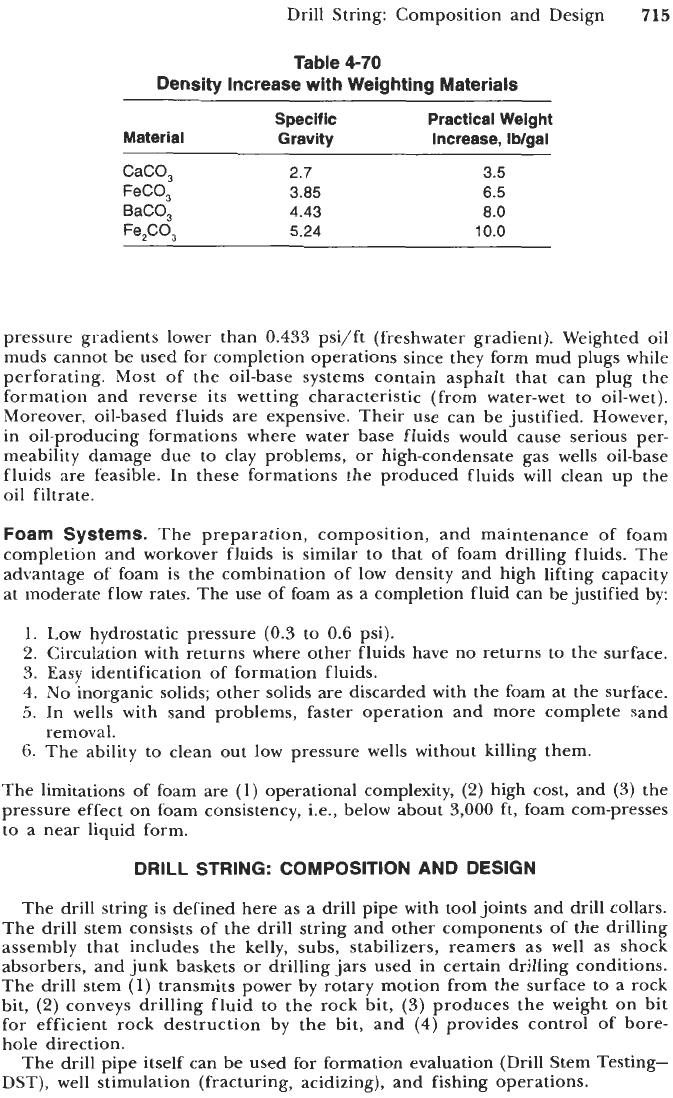
Drill String: Composition and Design
715
Table
4-70
Density Increase with Weighting Materials
Specific Practical Weight
Material Gravity Increase, Ib/gal
CaCO,
2.7
FeCO,
3.85
FeP,
5.24
BaCO,
4.43
3.5
6.5
8.0
10.0
pressure gradients lower than
0.433
psi/ft (freshwater gradient). Weighted oil
muds cannot be used for completion operations since they form mud plugs while
perforating. Most of the oil-base systems contain asphalt that can plug the
formation and reverse its wetting characteristic (from water-wet to oil-wet).
Moreover, oil-based fluids are expensive. Their use can be justified. However,
in oil-producing formations where water base fluids would cause serious per-
meability damage due to clay problems, or high-condensate gas wells oil-base
fluids are feasible.
In
these formations the produced fluids will clean up the
oil filtrate.
Foam Systems.
The preparation, composition, and maintenance of foam
completion and workover fluids is similar to that
of
foam drilling fluids. The
advantage of foam
is
the combination of low density and high lifting capacity
at moderate flow rates. The use of foam as a completion fluid can be justified by:
1.
Low hydrostatic pressure
(0.3
to
0.6
psi).
2.
Circulation with returns where other fluids have no returns to the surface.
3.
Easy identification of formation fluids.
4.
No
inorganic solids; other solids are discarded with the foam at the surface.
5.
In
wells with sand problems, faster operation and more complete sand
6. The ability to clean out low pressure wells without killing them.
removal.
The limitations of foam are
(1)
operational complexity,
(2)
high cost, and
(3)
the
pressure effect on foam consistency, Le., below about
3,000
ft, foam com-presses
to a near liquid form.
DRILL STRING: COMPOSITION AND DESIGN
The drill string is defined here as a drill pipe with tool joints and drill collars.
The drill stem consists
of
the drill string and other components of the drilling
assembly that includes the kelly, subs, stabilizers, reamers as well as shock
absorbers, and junk baskets or drilling jars used in certain drilling conditions.
The drill stem
(1)
transmits power by rotary motion from the surface to a rock
bit,
(2)
conveys drilling fluid to the rock bit,
(3)
produces the weight on bit
for efficient rock destruction by the bit, and
(4)
provides control of bore-
hole direction.
The drill pipe itself can be used for formation evaluation (Drill Stem Testing-
DST), well stimulation (fracturing, acidizing), and fishing operations.

716
Drilling and Well Completions
Therefore, the drill string is a fundamental part, perhaps one of the most
The schematic, typical arrangement of a drill stem is shown in Figure
4-126.
important parts,
of
any drilling activity.
Drill
Collar
The term "drill collar" originally derives from the short sub originally used
to connect the bit to the drill pipe. Modern drill collars are each about
30
ft
in length, and the total length of the string of drill collars may range from about
100
to
700
ft and more.
ROTARY BOX
CONNECTION L.H. SWIVEL STEM
ROTARY PIN
CONNECTION L.H.
ROTARY
BOX
ROTARY PIN
CONNECTION L.H.
ROTARY
BOX
CONNECTION L.H.
UPPER UPSET
TOOL JOINT
@OX
MEMBER
DRILL PIPE
TOOL JOINT
CONNECTION
DRILL COLLAR
CONN ECTlON
(SOUAREORHEXAGON)
NOTE:
(SOUARE ILLUSTRATE01
ALL CONNECTIONS
BETWEEN "LOWER
UPSET" OF KELLY
AN0
'EIT"
ARC
R.H.
LOWER UPSET
ROTARY PIN
CONNECTION
ROTARY
BOX
CONNECTION
ROTARY PIN
CONNECTION
ROTARY PIN
CONNECTION
I
Figure
4-126.
Typical drill-stem assembly
[13].
Requirements on swivel and swivel
sub
connections are included in
API
spec
8A.
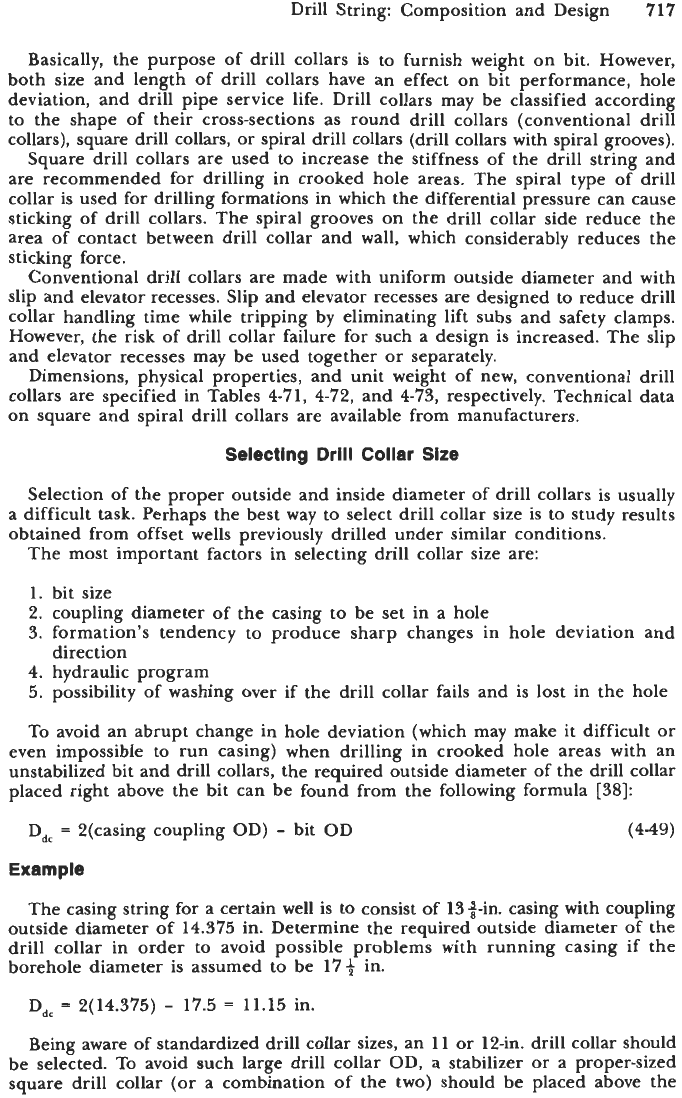
Drill String: Composition and Design
717
Basically, the purpose of drill collars is
to
furnish weight on bit. However,
both size and length of drill collars have an effect on bit performance, hole
deviation, and drill pipe service life. Drill collars may be classified according
to the shape of their cross-sections as round drill collars (conventional drill
collars), square drill collars,
or
spiral drill collars (drill collars with spiral grooves).
Square drill collars are used to increase the stiffness of the drill string and
are recommended for drilling in crooked hole areas. The spiral type
of
drill
collar is used for drilling formations in which the differential pressure can cause
sticking
of
drill collars. The spiral grooves on the drill collar side reduce the
area
of
contact between drill collar and wall, which considerably reduces the
sticking force.
Conventional drill collars are made with uniform outside diameter and with
slip and elevator recesses. Slip and elevator recesses are designed to reduce drill
collar handling time while tripping by eliminating lift subs and safety clamps.
However, the risk of drill collar failure for such a design is increased. The slip
and elevator recesses may be used together
or
separately.
Dimensions, physical properties, and unit weight of new, conventional drill
collars are specified in Tables
4-71, 4-72,
and
4-73,
respectively. Technical data
on square and spiral drill collars are available from manufacturers.
Selecting
Drill Collar
Size
Selection of the proper outside and inside diameter of drill collars is usually
a difficult task. Perhaps the best way to select drill collar size is to study results
obtained from offset wells previously drilled under similar conditions.
The most important factors in selecting drill collar size are:
1.
bit size
2.
coupling diameter of the casing to be set in
a
hole
3.
formation’s tendency to produce sharp changes in hole deviation and
4.
hydraulic program
5.
possibility of washing over if the drill collar fails and is lost in the hole
To avoid an abrupt change in hole deviation (which may make it difficult or
even impossible to run casing) when drilling in crooked hole areas with an
unstabilized bit and drill collars, the required outside diameter of the drill collar
placed right above the bit can be found from the following formula
[38]:
direction
Ddc
=
2(casing coupling OD)
-
bit OD
(4-49)
Example
The casing string for
a
certain well is to consist of
13
+-in. casing with coupling
outside diameter
of
14.375
in. Determine the required outside diameter
of
the
drill collar in order
to
avoid possible problems with running casing if the
borehole diameter is assumed
to
be
17+
in.
Ddc
=
2(14.375)
-
17.5
=
11.15
in.
Being aware of standardized drill collar sizes, an
11
or
12-in.
drill collar should
be selected. To avoid such large drill collar OD, a stabilizer
or
a proper-sized
square drill collar
(or
a combination of the two) should be placed above the
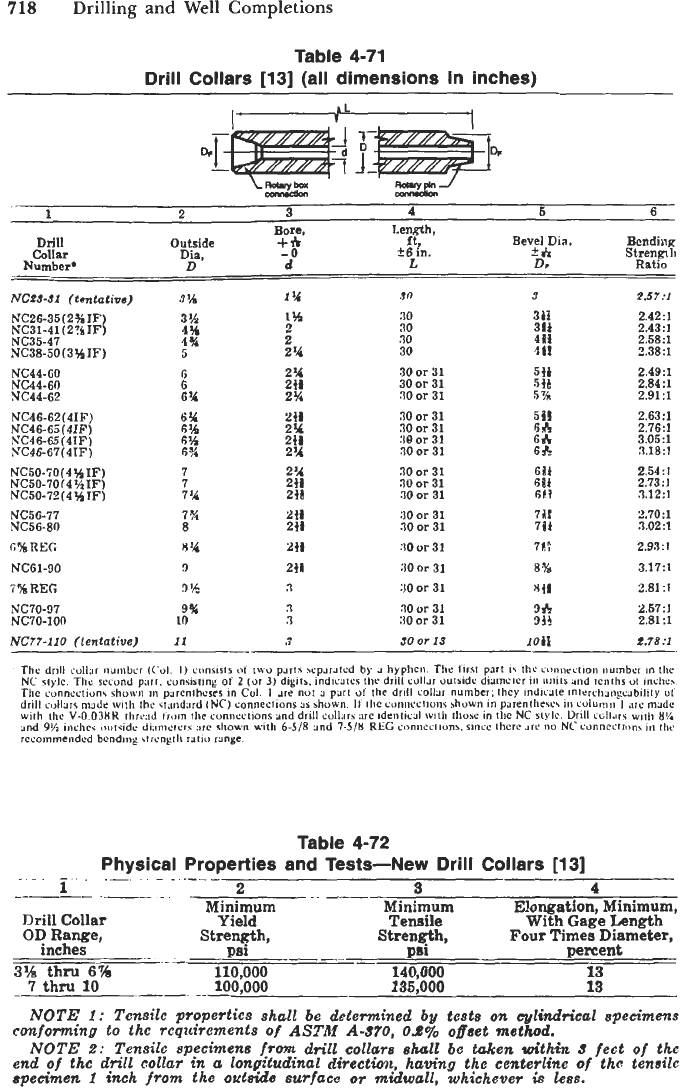
718
Drilling
and
Well
Completions
Table 4-71
Drill Collars
[la]
(all dimensions In inches)
0
A
R
6
Drill
Collar
Number'
Bore.
Len&h,
ft, Bevel Dia, Bendiaa
+6
in.
+*
Strenglli
L
D.
Ratio
+P
Outside
Dia,
D
d
NCOJ-31
(tentative)
3%
1%
d
n
3
2.57:1
1%
2
2
2%
NC26-35(2% IF
3%
NC35-47
441
NC38-50(32bIF)
5
h'C31-41(2?6IF1 4%
NC44-GO
NC44-60
NC4442
NC46-62(4IF)
NC46-65(4IF)
NC46-65 (4IF)
NC46-67(4lF)
6
6
6%
2%
21t
2%
6%
Bf8
6%
2%
6%
2tl
6
U
2%
NC50-70(4HIF)
7
NC50-I0 14 %IF)
I
NC50-12(4%IF)
7
'k
2%
2ti
231
30
30
30
30
30
or
31
30
or
31
30
or
31
311
2.42:l
31t
2.43:l
48f
2.58:l
4
L!
?.38:1
2.493
2.84:l
2.91:l
30
or
31
5
$4
2.63:l
?O
or 31
62%
2.16:1
.I0
or
31
6dc
3.05:l
30
or
31
G&
3.18:l
30
or
31
30 or
31
30
or
31
68t
681
6&?
2.54
:
I
2.13:J
3.12:l
:IO
or
31
IAI
2.70:l
30
or
31
745
3.02:l
NC56-I7
7%
248
NC56-80
8
2
ti
G16REC
nx
at*
:10
or
31
14:
2.93:l
NCG1-DO
n
21)
30
or
31
8%
3.11:1
TWREG
n
1.
3
30
or
31
*ti
2.81:l
NCIO-97
9%
3
30
or
31
9*
2.51:J
2.81:l
NC70-10n
10
n
:IO
or
31
914
NC77-110
(tentative)
11
30
or
IS
loif
2.78:1
The dnll
coll.jr
nan1bl.r
(CUI.
I)
umsists
01
two
pJr1 uted by
J
hyplicn
Tlic lirst part
is
the connection number
in
the
NC
siylc.
Tlic
secund
pri.
conuating
of
2
(or
3)
dig diutes
tlie
drill d1Jr uutvdu diwnetcr
111
units
and tenths
ut
inher
The
connectionr rhoxvn in parcnlhcres in
CUI
I
are
not
a
part
of
the drill
collar
number; they indicate inlerchdny~bihty
"1
drill
cvllars
nude
with
the .;l.indard
tNC)
connections
as
shoun
II
the
co~~ncct~oi~~
shown
in
prrentl~rrc*
in
uulumil
I
.ire
made
wit11
the
V-0.03HH
ilir...!d Irm
the
connections
and
drill coll.irs
ire
idmticil
with
lliose
in
the
NC
style.
Vrill
cc;ll.ir\
wit11
M%
and
9%
inche\ outside diameters
.I~P
shu~n
with
6.518
and
1-5/H
REG
connccliun,.
since
lhcre
drr
nu
NC-
cunncctionr
111
tllc
recommended bending \trength
ratio
range.
Table 4-72
Physical Properties and Tests-New Drill Collars [13]
--
i
--
2
3
4
Minimum Minimum Elongation, Minimum,
Drill
Collar Yield Tensile With. Gage Length
OD
Range, Strength, Strength, Four Times Diameter,
3%
thru
6%
110,000
140,000
13
7
thru
10
100,000
135,000
13
--
.__
___
-
psi percent
-
PSI
--
inches
NOTE
1:
Tensile properties shall be determined by tests
on
cylindrical
specimens
conforming
to
the rcqriirements
of
ASTM
A-$70,
03%
offset
method.
NOTE
2:
Tensile specimens
from
drill collars
shall
be taken within
S
feet
of
the
end
of
the drill collar in
a
longitudinal directwit, having the centerline
of
tho tensilc
speeimen
1
inch
from
the outside surfacs
or
midwall, whichever
is
less.
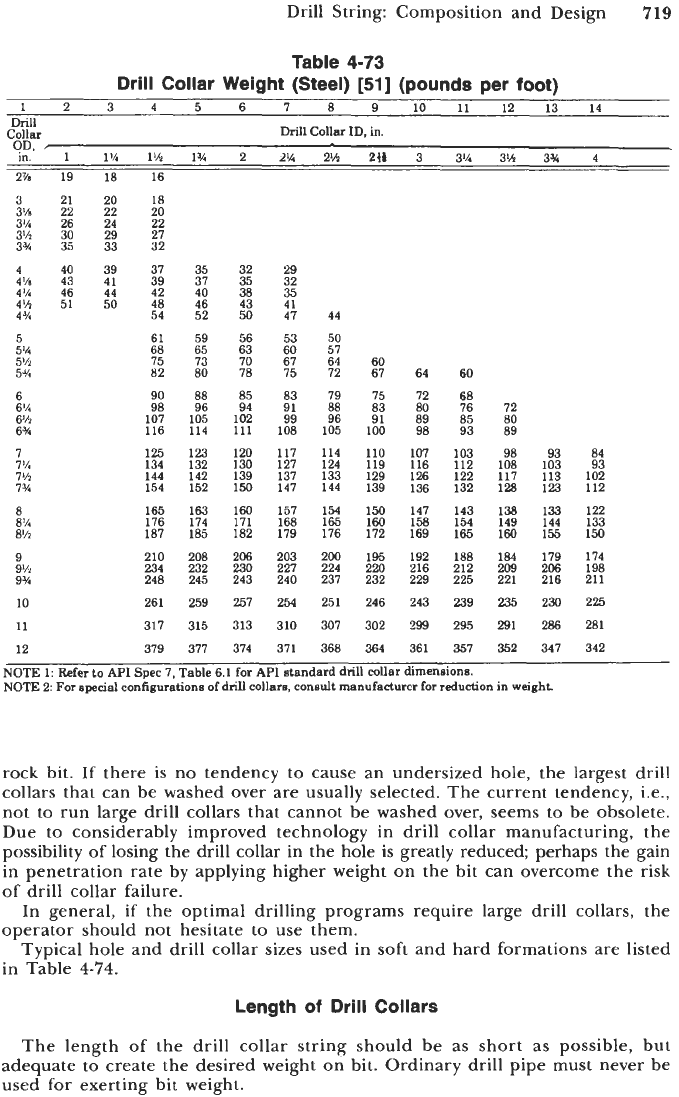
Drill String: Composition and Design
719
Table
4-73
Drill Collar Weight (Steel)
[Sl]
(pounds per foot)
12 3 4 5 6 7 8 91011121314
Dnll
Collar
Drill
Collar
ID.
in.
:I?
'
1
1% 1% 1% 2
2%
2k
at*
3 3% 3% 3% 4
2%
3
3%
3%
3%
3%
4
41%
4
'A
41%
4
3A
5
5%
5%
5%
6
6%
6'h
6%
7
7
1%
7%
7
3A
8
8
%
81%
9
9%
9%
10
11
12
19 18 16
21 20 18
22 22 20
26 24 22
30 29 27
35 33 32
40 39 37
43 41 39
46 44 42
51 50 48
54
61
68
75
82
90
98
107
116
125
134
144
154
165
176
187
210
234
248
261
317
379
35
37
40
46
52
59
65
73
80
88
96
105
114
123
132
142
152
163
174
185
208
232
245
259
315
377
32 29
35 32
38
35
43 41
50 47
56 53
63 60
70 67
78 75
85 83
94 91
102 99
111
108
120 117
130 127
139 137
150 147
160 157
171 168
182 179
206 203
230 227
243 240
257 254
313 310
374 371
44
50
57
64
72
79
88
96
105
114
124
133
144
154
165
176
200
224
237
251
307
368
60
67
75
83
91
100
110
119
129
139
150
160
172
195
220
232
246
302
364
64
72
80
89
98
107
116
126
136
147
158
169
192
216
229
243
299
361
60
68
76 72
85 80
93 89
103 98
93 84
112 108 103 93
122
117
113 102
132 128
123 112
143 138
133 122
154
149
144 133
165 160
155 150
188 184
179 174
212
209
206 198
225 221
216 211
239
235
230 225
295
291
286 281
357 352
347 342
NOTE
1:
Refer
to
API
Spec
7,
Table
6.1
for
API
standard drill collar dimensions.
NOTE
2:
For apecial configurations
of
drill collars, consult manufacturcr for reduction in weight
rock bit.
If
there is no tendency to cause an undersized hole, the largest drill
collars that can be washed over are usually selected. The current tendency, i.e.,
not to run large drill collars that cannot be washed over, seems to be obsolete.
Due to considerably improved technology in drill collar manufacturing, the
possibility of losing the drill collar in the hole is greatly reduced perhaps the gain
in penetration rate by applying higher weight on the bit can overcome the risk
of drill collar failure.
In general, if the optimal drilling programs require large drill collars, the
operator should not hesitate to use them.
Typical hole and drill collar sizes used in soft and hard formations are listed
in Table
4-74.
Length
of
Drill Collars
The length of the drill collar string should be as short as possible, but
adequate to create the desired weight on bit. Ordinary drill pipe must never be
used for exerting bit weight.
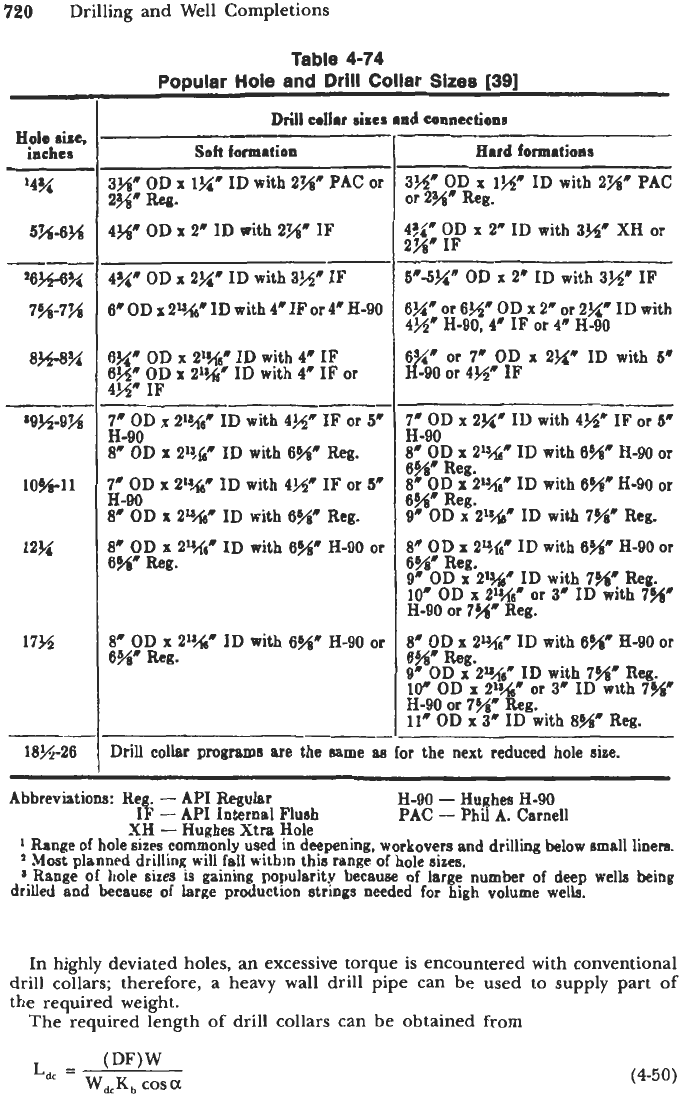
720
Drilling
and
Well Completions
Table
4-74
Popular
Hole
and Drill Collar
Sizes
[39]
Drill
collar
ires
md
connections
Soft
formation
3%"
OD
x
1%"
ID
with
2%'
PAC
or
2%"
Reg.
4%'
OD
x
2'
ID
with
2%"
IF
4%"
OD
x
2%"
ID
with
3%'
IF
6"
OD
x
29&?
ID
with
4'
IF
or
4"
H-90
6%"
OD
x
2'%6"
ID
with
4"
IF
6%;
OD
x
Z1*9&."
ID
with
4"
IF
or
4%
IF
7"
OD
x
21!# ID with
4%"
IF
or
5"
8"
OD
x
21Jis'
ID
with
6%"
Reg.
H-90
7'
OD
x
2YA"
ID
with
4%"
IF
or
5"
8"
OD
x
21s%$ju ID with
6%"
Reg.
H-90
8"
OD
x
2u4"
ID
with
6%"
H-DO
or
6%"
Reg.
8"
OD
x
294'
6%"
Reg.
ID with
6%"
H-90
or
-
Bard formations
3%"
OD
x
1%"
ID
with 2%"
PAC
or
2%" Reg.
4?i"
OD
x
2'
ID
with
334'
XH
or
2%"
IF
5"-5%"
OD
x
2"
ID with
3%"
IF
6%"
or
6%"
OD
x
2"
or
2%"
ID
with
4%"
H-90,4"
IF
Ot
4"
H-90
6%"
or
7'
OD
x
2%'
ID
with
5"
H-90
or
434"
IF
-~
7'
OD
x
2%"
ID
with
4%"
IF
or
5"
H-90
8>
OD
x
2u?"
ID
with 6%"
H-90
or
6%"
Reg.
8"
OD
x
29A6"
ID
with
6%"
H-90
or
6%"
Reg.
9"
OD
x
294"
ID with
7%"
Reg.
8"
OD
x
296" ID with
6%"
H-90
or
6%"
Reg.
9"
OD
x
21%"
ID
with
7%:
Reg.
10"
OD
x
2*?Q
or
3'
ID
with
7%"
H-90
or
7%"
Reg.
8"
OD
x
ZB46"
ID
with
6%" 3-90
or
6%"
Reg.
9"
OD
x
2u?" ID with
794"
Reg.
lo"
OD
x
21""
or
3"
ID
with
7%'
H-90
or
7%"
Reg.
11"
OD
x
3"
ID with
8%"
Reg.
Drill
collar programs are the
name
as
for
the next reduced hole size.
Abbreviations:
Reg.
-
API
Regular
H-90
-
Hughes
H-90
PAC
-
Phii
A.
Carnell
IF
-
API
Internal
Flush
XH
-
Hughes
Xtra
Hole
Flange
of
hole
sizes
commonly used in defpening, workovers and drilling below
small
hem.
Most
planned drlhg will fall
witbin
this
range
of
hole
sizes.
'.Range
of
hole
sizes
U
gaining popularity because
of
large number
of
deep wells being
drilled and because
of
large production
strings
needed
for
high
volume
wells.
In
highly deviated holes,
an
excessive torque is encountered with conventional
drill collars; therefore,
a
heavy wall drill
pipe
can
be
used to supply part of
the
required
weight.
The
required length of drill collars can
be
obtained from
(4-50)

Drill String: Composition and Design
721
where DF
=
W=
Wd‘
=
%=
K,
=
r,
=
r,,
=
a=
design factor (DF
=
1.1-1.2)
weight on bit in lb
unit weight of drill collar in air in lb/ft
buoyancy factor
drilling fluid density, e.g., in lb/gal
drill collar density, e.g., in Ib/gal (for steel,
y,,
=
65.5 lb/gal)
hole inclination from vertical in degrees
(”)
1
-
Ym/Ysc
Design factor (DF)
is
needed to place the neutral point below the top of the
drill collar string. Some excess of drill collar weight is required to take care of
inaccurate handling of the brake by the driller. For an “ideal driller,” the design
factor should be equal to
1.
The excess of drill collars also helps to prevent
transverse movement of drill pipe due to the effect of centrifugal force. While
the drill string rotates, a centrifugal force is generated that may produce a lateral
movement of drill pipe and, in turn, bending stress and excessive torque. The
centrifugal force also contributes to vibration of the drill pie. Hence, some
excess of drill collars is suggested. The magnitude of the design factor can be
determined by field experiments in any particular set of drilling conditions.
The pressure area method
(PAM),
occasionally used for evaluation of drill
collar string length, is wrong because it does not consider the triaxial state of
stresses that actually occurs. It must be remembered that hydrostatic forces
cannot cause any buckling of the drill string as long as the density of the string
is greater than the density of the drilling fluid.
Example
Determine the required length of
7
by 2t-in. drill collars if desired weight
on bit is
W
=
40,000 lb, drilling fluid density
y,
=
100 lb/gal, and hole deviation
from vertical
a
=
20”. From offset wells, it is known that a design factor DF of
1.1
is
satisfactory.
Solution
From Table 4-75 the unit weight
of
drill collar WdC
=
117 lb/ft. The buoyant
factor
is
10
K,
=
1
-
-
=
0.847
65.5
Applying Equation 4-50 gives
(1‘1)(40,000)
=
376ft
(147)(0.847)(cos20)
L,,
=
The closed length, based on 30-ft collars, is 390 ft or 13 joints of drill collars.
Actually, drill collar sizes and lengths should be considered simultaneously.
The optimal selection should result in the maximum penetration rate. Such an
approach, however complex, is particularly important when drilling formations
sensitive to the effect of differential pressure and also in cases where the amount
of hydraulic energy delivered at the rock bit is a controlling factor
of
drill-
ing efficiency.
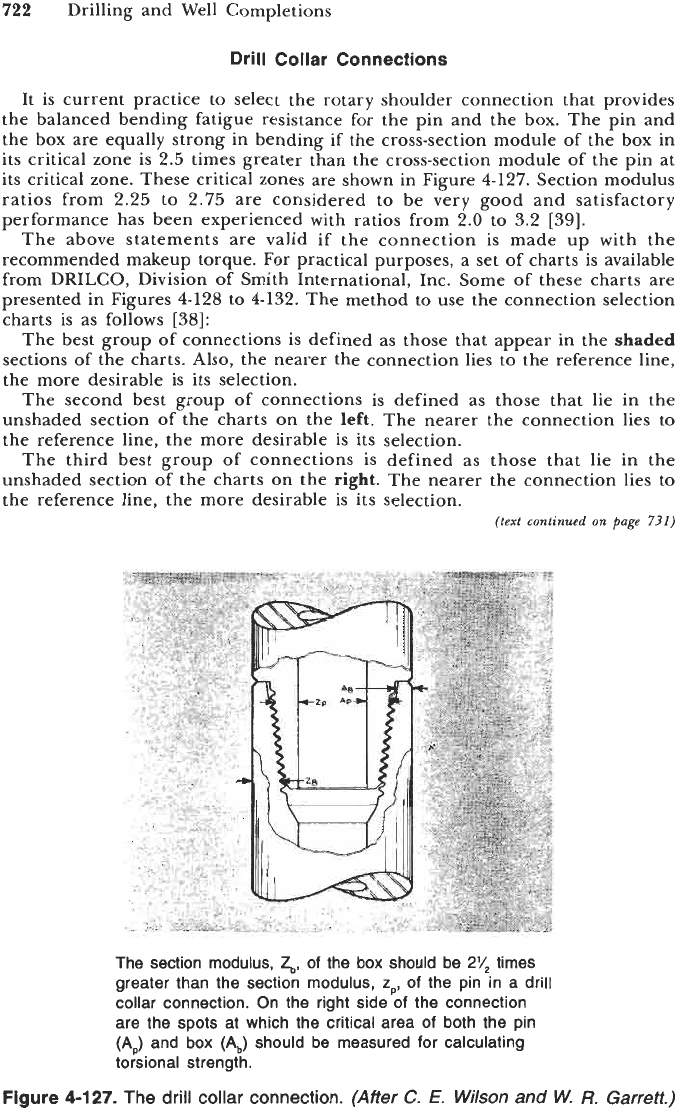
722
Drilling and Well Completions
Drill Collar Connections
It is current practice to select the rotary shoulder connection that provides
the balanced bending fatigue resistance for the pin and the box. The pin and
the box are equally strong in bending if the cross-section module of the box in
its critical zone is
2.5
times greater than the cross-section module of the pin at
its critical zone. These critical zones are shown in Figure
4-127.
Section modulus
ratios from
2.25
to
2.75
are considered to be very good and satisfactory
performance has been experienced with ratios from
2.0
to
3.2 [39].
The above statements are valid if the connection is made up with the
recommended makeup torque. For practical purposes, a set of charts is available
from DRILCO, Division of Smith International, Inc. Some of these charts are
presented in Figures
4-128
to
4-132.
The method to use the connection selection
charts is as follows
[38]:
The best group of connections is defined as those that appear in the
shaded
sections
of
the charts. Also, the nearer the connection lies to the reference line,
the more desirable is its selection.
The second best group of connections is defined as those that lie in the
unshaded section of the charts on the
left.
The nearer the connection lies to
the reference line, the more desirable is its selection.
The third best group of connections is defined as those that lie in the
unshaded section of the charts on the
right.
The nearer the connection lies to
the reference line, the more desirable is its selection.
(text continued
on
page
731)
The section modulus,
<,
of the box should be
2%
times
greater than the section modulus,
zp,
of the pin in a drill
collar connection. On the right side of the connection
are the spots at which the critical area of both the pin
(A,)
and box
(A,)
should be measured for calculating
torsional strength.
Figure
4-127.
The
drill collar connection.
(After
C.
E.
Wilson and
W.
R.
Garrett.)

Drill String: Composition and Design
723
2”
ID
Reference
Line
Figure
4-1
28.
Practical chart for drill collar selection-2-in.
ID.
(From
Drilco,
Division
of
Smith International, lnc.)

724
Drilling
and
Well Completions
2%"
ID
Figure
Drilco,
I
Reference
Line
4-129.
Practical chart for drill collar selection-2 +-in.
ID.
(from
Division
of
Smith International, Inc.)
